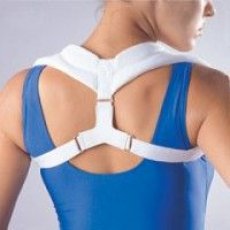Medical expert of the article
New publications
Pain in the clavicle
Last reviewed: 04.07.2025

All iLive content is medically reviewed or fact checked to ensure as much factual accuracy as possible.
We have strict sourcing guidelines and only link to reputable media sites, academic research institutions and, whenever possible, medically peer reviewed studies. Note that the numbers in parentheses ([1], [2], etc.) are clickable links to these studies.
If you feel that any of our content is inaccurate, out-of-date, or otherwise questionable, please select it and press Ctrl + Enter.

What causes collarbone pain?
Clavicle fracture
One of the most common causes of collarbone pain can be a collarbone fracture. Of all the different types of bone fractures, collarbone fractures account for almost 5%. There are many causes of collarbone injuries and fractures. It can be a blow or a fall. A fall on the shoulder can also lead to a collarbone fracture. In addition, a direct blow or injury to the collarbone can also lead to a collarbone fracture, thereby causing pain in and around the collarbone area.
Other Causes of Collarbone Pain
An injury to the acromioclavicular joint, which causes separation between the shoulder joint and the collarbone, can also cause pain. Osteolysis of the collarbone is a condition in which the bone is destroyed due to increased osteoclast activity. Chest and rib injuries can also cause collarbone pain. Certain bone diseases or bursitis can also cause collarbone pain. Other rare causes include degeneration of the collarbone.
What is the collarbone?
The collarbone (from Latin, “collarbone” translates as “little key”) is a horizontally located bone in the upper chest. This bone forms a unique connection between the upper limb and the rib cage. It transfers the weight of the upper limb (or any weight that our arms carry) to the central part of the body. Therefore, any damage to the collarbone significantly reduces the throughput of the arms and makes them practically useless for a person.
The collarbone attaches to the breastbone (sternum) and the shoulder blade. It provides stability and support to the joints. The entire length of this bone can be easily felt on the upper chest. The collarbone holds the shoulder blades in a stable position, allowing the arms to move freely.
Symptoms that may accompany collarbone pain
Pain in the collarbone is felt during active movements of the upper limb. Acute pain may join this.
One of the most common symptoms accompanying pain is swelling in the collarbone. The swelling can be quite localized or radiate to the neck and shoulder girdle.
Once the swelling subsides, the destruction of the collarbone can be felt directly through the skin. The person may suffer from referred pain in the collarbone area, including muscle pain. Other systemic symptoms may also occur, such as nausea, dizziness, visual disturbances due to pain, etc.
How to treat collarbone pain?
Treatment will depend on the cause of the collarbone pain. If the pain is due to a collarbone fracture, treatment will include resting the affected limb and supporting the arm with a sling.
The use of slings along with painkillers helps the bone to gain the ability to heal itself. However, in about 5-10% of cases, surgical methods are used. There is a need for surgical intervention in cases where there is bone fragmentation with separation, penetration of bone parts through the skin, shortening of the collarbone, separation of bone fragments, even after several months, etc. The surgical procedure will entail fixation with plate fixation. In this procedure, a titanium or steel plate fixes the bone with screws.
There are, however, many disadvantages of surgical treatment of clavicle fractures such as infection, adverse neurological symptoms, separation of bone fragments, etc. The healing of the post-operative sites will depend on many factors such as the age of the patient, his health, the complexity and location of the fracture, the ability of the bone to move, etc. Adults may take 20-30 days to recover from this condition. However, children and young adults can recover within 15 days. In cases where the pain is due to some other cause, the treatment will vary accordingly.
Collarbone fracture and damage is mostly seen in people who are active in sports. Therefore, in such cases, it is best to wear protective clothing to prevent collarbone fracture and damage, as well as collarbone pain.


 [
[